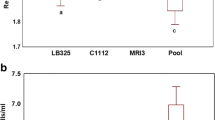Abstract
Rice, parboiled rice, finger millet, germinated finger millet, broken wheat, njavara (medicinal rice), sorghum and maize were used as substrates for solid state fermentation of Monascus purpureus at 28°C for 7 days using 2% seed medium as inoculum for the production of its metabolites. The fungus exhibited good growth in all the substrates. The fermented substrates were dried at 45°C and analysed for antihypercholesterolemic metabolite statins by standardized HPLC method and dietary sterol contents by spectrophotometric method using reference standards of statin (pravastatin and lovastatin) and cholesterol, respectively. Germinated finger millet yielded higher total statin production of 5.2 g/kg dry wt with pravastatin and lovastatin content of 4.9 and 0.37 g/kg dry wt respectively than other substrates which range from 1.04–4.41 g/kg. In addition to statin, monascus fermented germinated finger millet yielded dietary sterol of 0.053 g/kg dry wt which is 7.6 folds higher than the control. The value addition of finger millet by germination and fermentation with Monascus purpureus provides scope for development of functional food.
Similar content being viewed by others
References
Anon (2009) Ragi (finger Millet). Agricultural Marketing and Information Network, www.agmarknet.nic.in (17 March 2010)
Chen F, Hu X (2005) Study on red fermented rice with high concentration of monacolin K and low concentration of citrinin. Int J Food Microbiol 103:331–337
Chen M, Johns MR (1993) Effect of pH and nitrogen source on pigment production by Monascus purpureus. Appl Microbiol Biotechnol 40:132–138
Clifton P (2002) Plant sterols and stanols-comparison and contrasts. Sterols versus stanols in cholesterol-lowering: is there a difference? Atherosclerosis Suppl 3:5–9
Egorova OV, Nikolayeva VM, Sukhodolskaya GV, Donova MV (2009) Transformation of C19-steroids and testosterone production by sterol-transforming strains of Mycobacterium spp. J Molecular Catalysis B: Enzymatic 57:198–203
Ghanem KM, Ghanem NB, El-Refai AH (1990) Ergosterol production under optimized conditions by Penicillium crustosum Thom. J Islamic Acad Sci 3(1):30–34
Heber D, Yip I, Ashley JM, Elashoof DA, Elashoof RM, Go VL (1999) Cholesterol-lowering effects of a proprietary Chinese red yeast rice dietary supplements. Am J Clin Nutr 69: 231–236
Kieber RJ, Payne WJ, Appleton GS (1955) The sterol content of fungi-Methods for disrupting cells, extracting and determining sterols. Appl Environ Microbiol 3:249–251
Law M (2000) Plant sterol and stanol margarines and health. Br Med J 320:861–864
Lee CL, Wang JJ, Kuo SL, Pan TM (2006) Monascus fermentation of dioscorea for increasing the production of cholesterol lowering agent — monacolin K and antiinflammation agent — monascin. Appl Microbiol Biotechnol 72:1254–1262
Lichtenstein AH (2002) Plant sterol and blood lipid levels. Curr Opin Clin Nutr Metab Care 5:147–152
Manzoni M, Bergomi S, Rollini M, Cavazzoni V (1999) Production of statins by filamentous fungi. Biotechnol Lett 21: 253–257
Manzoni M, Rollini M (2002) Biosynthesis and biotechnological production of statin by filamentous fungus and application of these cholesterol lowering drugs. Appl Microbiol Biotechnol 58:555–564
Mbithi-Mwikya S, Van Camp J, Viru Y, Huyghebaert (2000) Nutrient and antinutrient changes in finger millet (Eleusine coracana) during sprouting. LWT Food Sci Technol 33:9–14
No HK, Meyers SP (2004) Preparation of tofu using chitosanas a coagulant for improved shelf life. Int J Food Sci Technol 39: 133–141
Ostlund RE (2002) Phytosterols in human nutrition. Ann Rev Nutr 22:533–549
Plat J, Mensink RP (2001) Effects of plant sterols and stanols on lipid metabolism and cardiovascular risk. Nutr Metabol Cardiovasc Dis 11:31–40
Pyo YP (2007) Production of a high value added soybean containing bioactive mevinolins and isoflavones. J Food Sci Nutr 12: 29–34
Sabir SM, Hayat I, Gardezi SDA. (2003) Estimation of sterols in edible fats and oils. Pakistan J Nutr 2(3):178–181
Sayyad SA, Panda BP, Javed S, Ali M (2007) Optimization of nutrient parameters for lovastatin production by Monascus purpureus MTCC 369 under submerged fermentation using response surface methodology. Appl Microbiol Biotechnol 73: 1054–1058
Simons LA (2002) Additive effect of plant sterol-ester margarine and cerivastatin in lowering low-density lipoprotein cholesterol in primary hypercholesterolemia. Am J Cardiol 90: 737–740
Sripriya G, Usha Antony, Chandra TS (1997) Changes in carbohydrate, free amino acids, organic acids, phytate and HCl extractability of minerals during germination and fermentation of finger millet (Eleusine coracana). Food Chem 58:345–350
Su YC, Wang JJ, Lin TT, Pan TM. (2003) Production of the secondary metabolites γ-aminobutyric acid and monacolin K by Monascus. J Ind Microbiol Biotechnol 30:41–46
Valera HR, Gomes J, Lakshmi S, Gururaja R, Suryanarayan S, Kumar, D (2005) Lovastatin production by solid state fermentation using Aspergillus flavipes. Enzyme Microbial Technol 37: 521–552
Wang JJ, Lee CL, Pan TM (2003) Improvement of monacolin K, γ-aminobutyric acid and citrinin production ratio as a function of environmental conditions of Monascus purpureus NTU 601. J Ind Microbiol Biotechnol 30:669–676
Author information
Authors and Affiliations
Corresponding author
Rights and permissions
About this article
Cite this article
Venkateswaran, V., Vijayalakshmi, G. Finger millet (Eleusine coracana) — an economically viable source for antihypercholesterolemic metabolites production by Monascus purpureus . J Food Sci Technol 47, 426–431 (2010). https://doi.org/10.1007/s13197-010-0070-9
Revised:
Accepted:
Published:
Issue Date:
DOI: https://doi.org/10.1007/s13197-010-0070-9




